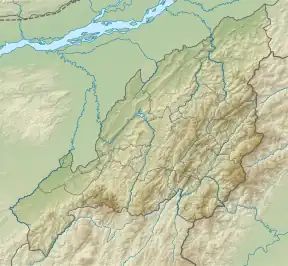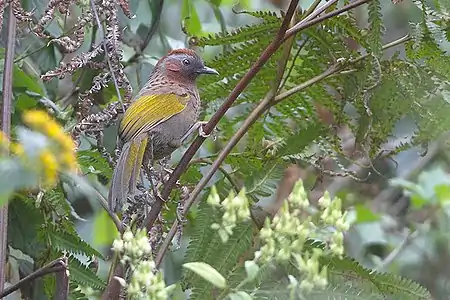| Khonoma Nature Conservation and Tragopan Sanctuary | |
|---|---|
| KNCTS | |
 Location in Nagaland, India | |
| Location | Kohima District, Nagaland |
| Nearest city | Kohima |
| Coordinates | 25°37′36″N 94°00′08″E / 25.6267°N 94.0021°E |
| Area | 25 square km |
| Governing body | Government of India, Government of Nagaland |
Khonoma Nature Conservation and Tragopan Sanctuary or KNCTS is a conservation reserve and a protected area in the Kohima District of the state of Nagaland in India. It is about 18 kilometres (11 mi) west of the capital of Nagaland, Kohima. The total area notified under this park is around 25 square kilometres (9.7 sq mi); some of villages and hamlets are adjacent to this park: Khonoma, Mezoma and Dzüleke. The sanctuary is home to several endangered mammal species, including the clouded leopard, Asiatic black bear, and hoolock gibbon, as well as over 300 avian species.[1]
The sanctuary was created in 1998, when alarmed after 300 endangered Blyth's tragopans (Tragopan blythii) were killed by the villagers in one week as part of a hunting competition, the village council demarcated a 20 sqkm area within which hunting was banned and the Khonoma Nature Conservation and Tragopan Sanctuary was created.[2]
Geography
This park lies at the extension of Barail Range; the mountain range complex of north-east India and the undisturbed primary virgin forest is a place for some of the range restricted avian fauna. KNCTS is an Important Bird Area; under criteria A1 (threatened species) and A2 (range restricted species)[3] with area code IN423,[4] as identified by BirdLife International.
Natural history
Ecoregions
The sanctuary includes portions of three ecoregions:[3]
Fauna
Birds some of the exotic species from North-east India are present in this wildlife sanctuary; like Blyth's tragopan, Mountain bamboo partridge, Crested Finchbill, Assam laughingthrush, Striped laughingthrush, Spot-breasted scimitar babbler, Flavescent Bulbul, Naga wren-babbler, to name a few. [5]
 Green cochoa (Cochoa viridis)
Green cochoa (Cochoa viridis) Assam laughingthrush (Trochalopteron chrysopterum)
Assam laughingthrush (Trochalopteron chrysopterum) Rusty-capped fulvetta (Alcippe dubia)
Rusty-capped fulvetta (Alcippe dubia)
Mammals like Binturong, Serow, Jungle cat, Barking Deer, Gayal, Pallas's squirrel, Himalayan striped squirrel, clouded leopard, Asiatic black bear, and hoolock gibbon can be seen in this park.[5][1]
Though deforestation and poaching was a major threat for nature and wildlife in Nagaland; however Khonoma may be considered one of the safest place for wild birds and mammals. Community conservation played a major role in protecting the biodiversity of the area.[6]
References
- 1 2 Rodrigues, Anne Pinto (28 May 2020). "India's first 'green' village adapts to life without tourists". The Guardian.
- ↑ Dey, Panchali (25 September 2020). "Khonoma, India's first green village—its journey from hunting to conservation". Times of India.
- 1 2 "Important Bird Areas in India - Nagaland" (PDF). ibcn.in. Archived from the original (PDF) on 28 March 2019. Retrieved 28 May 2021.
- ↑ "Important Bird Areas (IBAs) in India". wiienvis.nic.in. 16 February 2016.
- 1 2 "Fauna – Status of Environment related issues: Nagaland ENVIS Centre, Ministry of Environment and Forests, Govt. of India". nagenvis.nic.in. 27 May 2017. Archived from the original on 27 May 2017. Retrieved 28 May 2021.
- ↑ "Khonoma Village – Kalpavriksh". kalpavriksh.org. Retrieved 11 June 2020.
